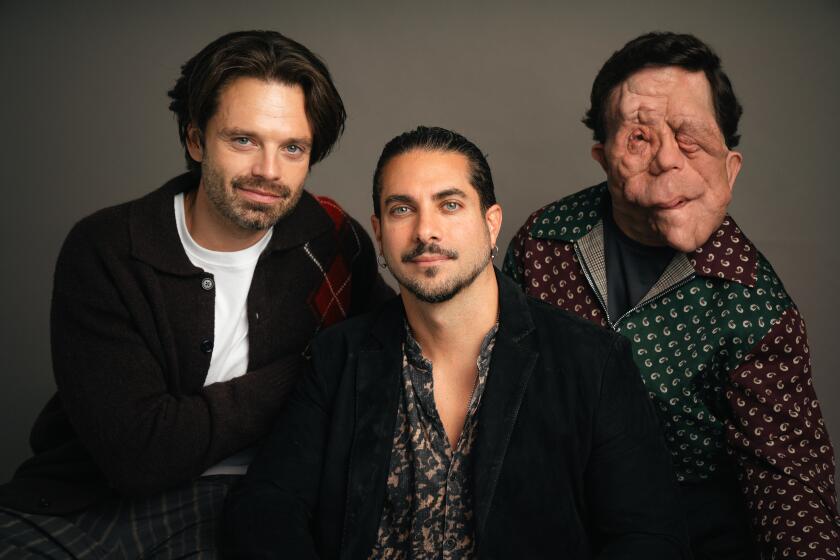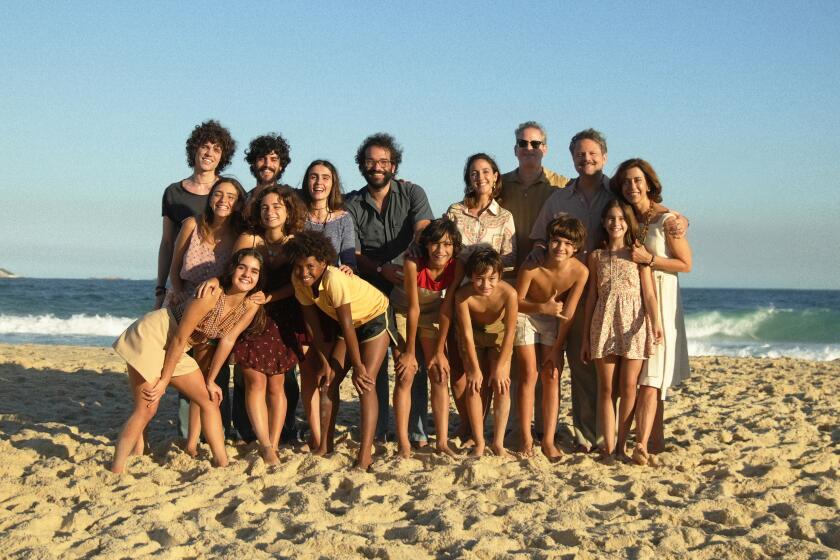
- Share via
Demi Moore and Margaret Qualley went through horrific transformations while playing two sides of the same woman in “The Substance.” Karla Sofía Gascón alone plays two incarnations of the same person — cartel boss Manitas and the title character after gender-affirming surgery in “Emilia Pérez.” Cynthia Erivo is the green-skinned Elphaba in “Wicked”; Bill Skarsgård is the clawed vampire Count Orlok in Robert Eggers’ “Nosferatu”; and Sebastian Stan struggles to find his inner goodness as a man with neurofibromatosis in “A Different Man.”
Five distinct films with a key commonality: All the character looks were created by this year’s hair and makeup Oscar nominees.
The Envelope reached out to those teams to find out just what went into these creations.
‘A Different Man’

Mike Marino, makeup designer
David Presto, prosthetic makeup artist
Crystal Jurado, prosthetic makeup artist
Proudest moment
Marino: The proudest moment was right after the first makeup test. We got to see Sebastian look in the mirror and start acting in the makeup. I knew then that it was going to work.
Jurado: To see it all work so well on the big screen was a real delight. It could have so easily looked like a big stiff mask, but instead, the makeup truly made Sebastian look like a man with neurofibromatosis. Being able to accurately represent people who have this condition is so very important.
Oscar-nominated makeup artist Mike Marino used groundbreaking prosthetics in collaboration with the actor Sebastian Stan for A24’s “A Different Man.”
Hardest look
Marino: The main makeup for Edward (Stan), since he is wearing full-face prosthetics and little pieces around the neck. The difficulty each day with the look was the constant change of his skin conditions. Some days were clean, and then some days he was scabby and flaking.
Presto: Edward’s look was the most difficult makeup I’ve ever been a part of — it took three of us, every day, to complete. What made it more arduous was our working [space]. There was no makeup trailer. Every day we had to lug our gear to each location in New York City and set up. At the end of the day, we would clean up Sebastian, pack our kits and be ready to do it all over again the next day.
Jurado: Definitely the day where Edward starts ripping his face off. The softness and weight of the appliances made application extremely difficult, but it was so rewarding to see how successful the look was that we achieved.
Best solution to a problem
Presto: During the scene when Edward starts peeling his face in the mirror, we had to create a system for quick resets for each take. After brainstorming and testing, we used a special mix that included Methocel. This helped keep the rest time down to a minimum while still preserving the makeup.
Jurado: Sebastian has very thick hair, and because the appliance had to lay over part of his hair, which the wig sits on and combs into his natural hair, it was challenging to get his hair to lay super flat with hair product alone. We ended up using Opsite tape on top of his hair to press it down even further. This process also allowed us to use Pax paint over the Opsite to even further hide his natural hairline.
What would you do differently if you had to do it all again?
Marino: I wouldn’t change anything. I believe when a makeup is created and filmed, it is meant to be. When a character’s makeup is created, it’s alive, with flaws and all.
‘Emilia Pérez’

Emmanuel Janvier, co-head of hairstyling
Julia Floch-Carbonel, co-head of makeup
Jean-Christophe Spadaccini, SFX makeup artist
Proudest moment
Janvier: When we created the character of Manitas. The first time the final look was achieved, and we saw Karla’s satisfaction and how quickly she embraced the character ... it was a great moment of joy.
Floch-Carbonel: Emilia’s transformation was a team process, guided by artistic director Virginie Montel and director Jacques Audiard. The main challenge was to transform Karla Sofía Gascón’s features to help her portray pretransition Emilia as Manitas, the intimidating head of a drug cartel, and post-transition Emilia, the loving and generous woman. Besides the technical challenges, my fear was that the Manitas research and makeup testing process would hurt Karla psychologically and throw her [back] to the past, but she was really helpful, centered and happy with the result. Manitas was so far from Karla that she could be composed and embrace Manitas in her body language, voice and even her way of walking. It was amazing to see and a relief for me and probably my proudest moment.
Spadaccini: I read that some people thought that two different actors were playing Manitas and Emilia. That was a compliment I was really proud of.

Hardest look
Janvier: Bringing the characters back to something simpler, more understated and more tough. We tried many short-hair wigs but quickly fell into clichés — like a 1970s Mexican cartel leader in the style of Pablo Escobar. Yet we needed something that was simply present. For Emilia, it was about achieving a natural femininity, something maternal, without overplaying the transformation.
Floch-Carbonel: Manitas was the hardest look to create. Jacques said he wanted a scary Manitas, a “chimera” — a ghostlike existence — but the makeup had to remain realistic and believable. The reality is that Karla Sofía Gascón is a very sexy, beautiful woman with magnificent full lips and feline eyes, and we had to play around that. We still needed Manitas’ “scary” side while some of Karla’s feminine features remained, so we found inspiration in places like Mickey Rourke’s character in “The Wrestler” — the type who fought with bare hands but also kept a certain coquetry and ornamental (tattoo, long hair, thin eyebrows, metal teeth, tanning), so her beautiful full lips could fit in this character. I added a beard, teeth, shadows, texture and tattoos in order to distort Karla’s natural features and emphasize masculine features via prosthetics.
Spadaccini: On the base of the prosthetic nose and cheeks for Manitas, I added imperfections like damaged skin or a scar, which made his face look more realistic.
‘Nosferatu’

Traci Loader, makeup designer
Suzanne Stokes-Munton, hair designer
Proudest moment
Loader: Seeing everything come together on set for the first time — the makeup, hair, costumes, lighting, sets and the performances all aligning perfectly.
Hardest look
Loader: One of the toughest challenges was designing the makeup, particularly for Ellen (Lily-Rose Depp). Her looks had to subtly reflect the toll of her experiences throughout the film, both physically and emotionally, without being overdone. The goal was to keep the makeup grounded in realism while still contributing to the film’s tone.
Stokes-Munton: Robert initially requested the “V” parting for the Ellen character. I felt it would be distracting — “gilding the lily” (if you’ll pardon the pun), and probably better suited to the Anna character. A wig was made for Emma Corrin (as Anna) by my crew’s on-site wig department, closely overseen by Robert’s precise eye for detail. The application had its challenges as Emma has very thick, dark, short hair; but Ivana Nemcova nailed it! Lily got the “V” at the back, so all requests were accommodated.
Best solution to a problem
Loader: One challenge we faced was seeing the shine from the glue when we hand-laid facial hair or used lace pieces. We mixed Pros-Aide (a water-based medical-grade adhesive) and TS100 (a clear matting agent), which solved the issue.
What would you do differently?
Loader: If I could do it all again, I think I would have pushed more during preproduction to test out different designs for some characters. While I’m proud of how everything turned out, you never know what else you can come up with.
Prosthetic makeup designer Pierre Olivier Persin employed a series of techniques to create those eye-popping looks seen in ‘The Substance.’ Key to it all: properly blending materials.
‘The Substance’

Pierre Olivier Persin, special makeup effects designer
Stéphanie Guillon, key makeup artist
Proudest moment
Persin: The first day we had Gollum [what they called the last stage of aging for Moore’s Elisabeth Sparkle] on set in her full-body prosthetic makeup. That’s the only makeup we didn’t have the time to test before the shoot. We tested the head, of course, but not the full body.
Hardest look:
Persin: Monstro [the final merging of the two bodies], without a doubt.
Guillon: The evolution of the look on Demi when she went from her room to the bathroom to change [before a date] and violently remove the makeup, because it has to start proportioned in the beginning, and each time she sees herself in a mirror, it is degrading slowly and slowly until she is completely out of proportion and she removes it. And for Demi to not hurt herself, my teammate Lucky Nguyen and I were preparing the removing pad with product in it to make it easy and not too hard on the skin.
What would you do differently?
Persin: I wish we had a bit more time to build Monstro and the Blob, to fine-tune the jiggling motion when they move.
Guillon: I would be more precise and detailed in the execution of the beautiful look of Demi and Margaret.
‘Wicked’

Frances Hannon, hair, makeup and prosthetics designer
Laura Blount, crowd hair / makeup supervisor
Sarah Nuth, key hair stylist / makeup artist
Proudest moment
Blount: Seeing all the Emerald City looks come together on set, it felt like you were back in the golden era of Hollywood.
Hardest look
Blount: Building some of the more statuesque wigs with cages and creating hair origami to add to them.
Nuth: Translating the inspiration of Madame Morrible’s magical power of weather control and cloud formations into a hairstyle for Michelle Yeoh.
Best solution to a problem
Hannon: Discovering the neon drops that brought Elphaba’s skin to life.
Blount: Spraying the structural wigs with acrylic polyurethane to keep them in place during the high-energy choreography.
Nuth: Wet-setting hair into shapes and building wire structures to create hairstyles. This avoided the need for too many heated tools that can affect the color of the white and blond wigs.
What would you do differently?
Nuth: I would have spent more time soaking up this once-in-a-lifetime job and movie.
More to Read
From the Oscars to the Emmys.
Get the Envelope newsletter for exclusive awards season coverage, behind-the-scenes stories from the Envelope podcast and columnist Glenn Whipp’s must-read analysis.
You may occasionally receive promotional content from the Los Angeles Times.












